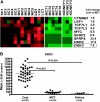Genetic variation of DKK3 may modify renal disease severity in ADPKD
- PMID: 20616171
- PMCID: PMC3013521
- DOI: 10.1681/ASN.2010030237
Genetic variation of DKK3 may modify renal disease severity in ADPKD
Abstract
Significant variation in the course of autosomal dominant polycystic kidney disease ( ADPKD) within families suggests the presence of effect modifiers. Recent studies of the variation within families harboring PKD1 mutations indicate that genetic background may account for 32 to 42% of the variance in estimated GFR (eGFR) before ESRD and 43 to 78% of the variance in age at ESRD onset, but the genetic modifiers are unknown. Here, we conducted a high-throughput single-nucleotide polymorphism (SNP) genotyping association study of 173 biological candidate genes in 794 white patients from 227 families with PKD1. We analyzed two primary outcomes: (1) eGFR and (2) time to ESRD (renal survival). For both outcomes, we used multidimensional scaling to correct for population structure and generalized estimating equations to account for the relatedness among individuals within the same family. We found suggestive associations between each of 12 SNPs and at least one of the renal outcomes. We genotyped these SNPs in a second set of 472 white patients from 229 families with PKD1 and performed a joint analysis on both cohorts. Three SNPs continued to show suggestive/significant association with eGFR at the Dickkopf 3 (DKK3) gene locus; no SNPs significantly associated with renal survival. DKK3 antagonizes Wnt/beta-catenin signaling, which may modulate renal cyst growth. Pending replication, our study suggests that genetic variation of DKK3 may modify severity of ADPKD resulting from PKD1 mutations.
Figures


References
-
- US Renal Data System: Excerpts from the USRDS 2004 Annual Data Report. Am J Kidney Dis 45: S1–S280, 2005
-
- Grantham J, Geiser J, Evan A: Cyst formation and growth in autosomal dominant polycystic kidney disease. Kidney Int 31: 1145–1152, 1987 - PubMed
-
- Pei Y: A “two-hit” model of cystogenesis in autosomal dominant polycystic kidney disease? Trends Mol Med 7: 151–156, 2001 - PubMed
-
- Nauli S, Rossetti S, Kolb R, Alenghat F, Consugar M, Harris P, Ingber D, Loghman-Adham M, Zhou J: Loss of polycystin-1 in human cyst-lining epithelia leads to ciliary dysfunction. J Am Soc Nephrol 17: 1015–1025, 2006 - PubMed
Publication types
MeSH terms
Substances
Grants and funding
LinkOut - more resources
Full Text Sources
Other Literature Sources
Research Materials
Miscellaneous

